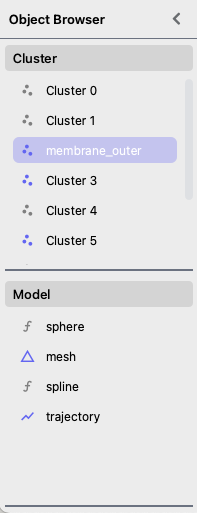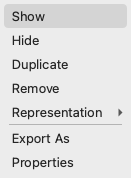Concepts#
This section introduces the fundamental concepts behind Mosaic and explains the main components of the user interface.
UI Layout#
The Mosaic interface consists of several key components:
Menu Bar: Access to file operations, view settings and help (on macOS its in the top menu)
Tab Bar: Switches between major functional areas
Segmentation: Work with point cloud data and analyze object properties
Parametrization: Create and operate on mathematical models
Intelligence: Advanced features (Dynamically Triangulated Surface simulations, constrained template matching, membrane segmentations)
Ribbon Toolbar: Context-specific tools for the active tab
Object Browser: Lists and manages loaded data with:
Visibility indicators with data types
Context menus for operations
Editable names
3D Viewport: Main visualization area with:
Navigation controls
Orientation indicators
Optional coordinate axes
Status Bar: Shows current interaction mode and application status
Additional dock widgets such as the Volume Viewer will be displayed at the bottom of the window.

Mosaic interface layout.#
Object Browser#

Object Browser#
The Object Browser is your central hub for managing all data in Mosaic. It displays all loaded objects in two main categories:
Clusters: Point cloud objects, e.g. a segmentation, where each point is defined by:
Position vector (X, Y, Z coordinates)
Unit quaternion to describe orientation (scalar-first w, x, y, z)
Models: Geometric shapes and surfaces including:
Fitted primitives (spheres, ellipsoids, cylinders)
Triangulated meshes
DTS simulation trajectories.
The symbol next to each object indicates the data type. The color of the symbol indicates if the object is shown or hidden.
Single click: Select one object
Double click: Edit object name
Ctrl+click: Add to selectionCtrl+A: Select all objectsShift+click: Select range
Interaction Modes#
Mosaic provides multiple interaction modes for selecting and modifying different types of data. The current mode is always displayed in the status bar at the bottom of the window and indicated by the cursor shape.
Tip
Every mode can be exited by pressing the key used to enter it or via Esc. Modes can also be activated via the Actions category in the menu bar.
Viewing Mode (Default)
Default camera navigation mode
Use mouse to rotate, pan, and zoom the 3D viewport
Press
Escto return to viewing mode from any other mode
Point Interaction#
Area Selection (Rubber Band)
Press
rto activate rectangular selection modeClick and drag in the 3D viewport to select points within a rectangular area
Press
eto expand selection to entire connected clustersPress
ragain orEscto exit selection mode
Point Drawing
Press
ato activate drawing modeClick anywhere in the 3D viewport to add new points to the selected cluster
If no cluster is selected, a new cluster will be created automatically
Press
aagain orEscto exit drawing mode
Curve Drawing
Press
Shift+Ato activate curve drawing modeClick to place points along a curve path
Press
Enterto save the curve as a new cluster of pointsPress
Shift+AorEscto cancel curve drawingOptional: Fit a curve model to the created cluster to parametrize it.
Object Selection#
Object Picking
Press
Eto activate object picking modeClick directly on objects (clusters or models) to select them
Press
sto switch between cluster and model selection targetsSelected objects are highlighted and selected in the Object Browser
Mesh Editing#
Mesh Delete
Press
qto activate mesh face selection modeClick on triangular faces to select them
Press
Deleteto remove selected facesPress
qorEscto exit
Mesh Add
Press
Qto activate mesh addition modeClick on three points to create a new triangular face
If any point is a vertex in an existing mesh, the face will be added to it
Press
QorEscto exit
Coordinate System#
Mosaic does not handle spatial units internally. Instead, imported data is immediately transformed into a consistent reference frame based on the sampling rate (typically Ångstroms for molecular data). This sampling rate is provided by the user or can be extracted from the header of particular file formats, e.g., mrc files.
Assuming a segmentation is loaded from an mrc file with a sampling rate of 6.80 Ångstroms per voxel, Mosaic will multiply the voxel coordinates with the sampling rate. Therefore, the internal scale would be in Ångstroms. The sampling rate also affects:
Display size
Filtering operations
Distance measurements
Export operations
Mosaic uses a right-handed coordinate system:
X-axis: Horizontal (left to right)
Y-axis: Vertical (bottom to top)
Z-axis: Depth (back to front)
The standard orientation is (0, 0, 1).
Next Steps#
Now that you understand the basic concepts and layout of Mosaic, proceed to the Working with Data section to learn how to handle different data types.
